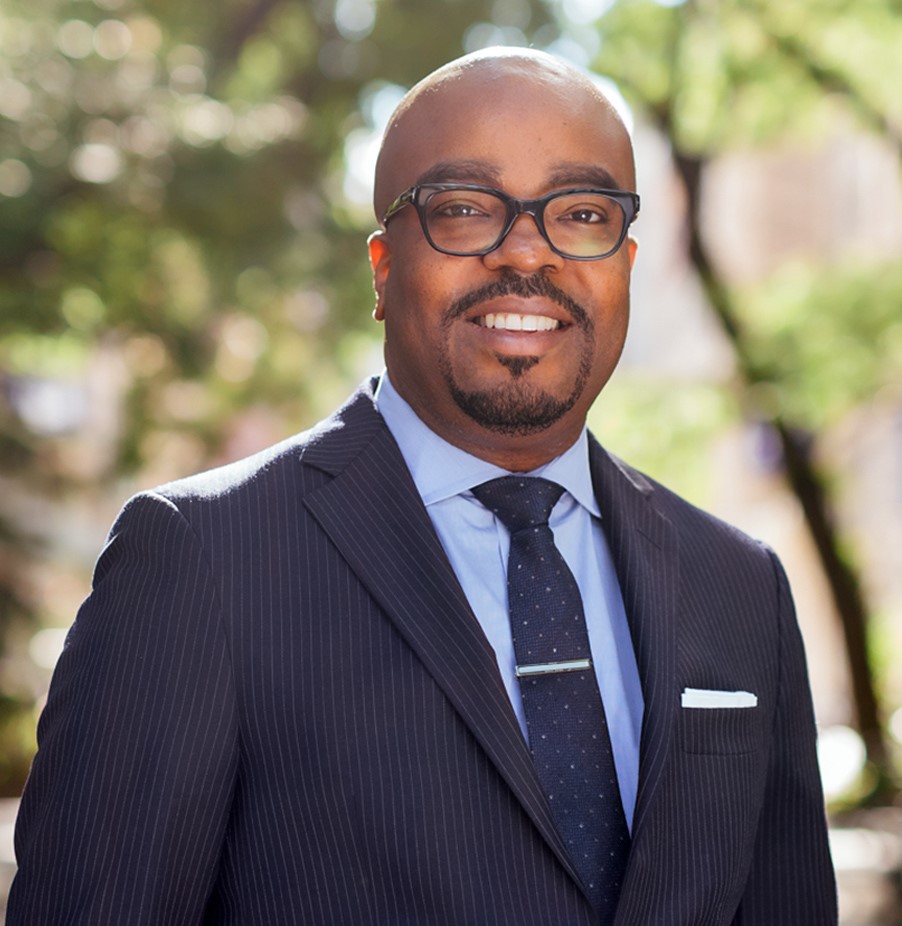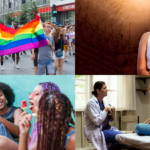Addressing the Crisis of Black Youth Suicide: Interview with Dr. Michael A. Lindsey
 Dr. Lindsey is the executive director of the McSilver Institute for Poverty Policy and Research at New York University. He also leads the working group of experts supporting the Congressional Black Caucus Emergency Task Force on Black Youth Suicide and Mental Health. The Task Force report, Ring the Alarm: The Crisis of Black Youth Suicide, released in December 2019, is a comprehensive examination of the alarming rise in suicide rates for Black youth over the past generation; a survey of available data and evidence; and a call for policymakers and communities to take action to better understand and to reverse this emergent trend.[1]
Dr. Lindsey is the executive director of the McSilver Institute for Poverty Policy and Research at New York University. He also leads the working group of experts supporting the Congressional Black Caucus Emergency Task Force on Black Youth Suicide and Mental Health. The Task Force report, Ring the Alarm: The Crisis of Black Youth Suicide, released in December 2019, is a comprehensive examination of the alarming rise in suicide rates for Black youth over the past generation; a survey of available data and evidence; and a call for policymakers and communities to take action to better understand and to reverse this emergent trend.[1]
TFAH: Please describe your work at the McSilver Institute.
Dr. Lindsey: We focus on the social determinants of mental health, as well as trauma and treatment disparities, all of which intersect with intergenerational poverty. If you are experiencing inequality related to, for example, food insecurity or underemployment, that has a psychological impact. We are looking for ways to break that cycle. We are committed to studying intergenerational poverty, not only to understand its consequences, but to also do something about it.
TFAH: Where does your passion for your work come from?
Dr. Lindsey: I’ve always been interested in mental health treatment disparities, particularly the lack of treatment access for serious mental health issues among Black people. I know the consequences of lack of mental health treatment. My passion derives from growing up in the Southeast section of Washington, D.C., where I saw the effects of drug use and undiagnosed, untreated addiction and mental health issues. I want to bridge that gap to make sure kids and families are connected to treatment in meaningful ways.
TFAH: If you could recommend to policymakers one or two actions that would make a real difference on the social determinants of mental health, what would they be?
Dr. Lindsey: Let’s focus that a bit. And that’s a key point. Whatever we design as an intervention has to speak to the unique issues that are experienced by a specific group. For example, looking at the rising rates of suicide among Black youth. We need to have mental health professionals in schools, proportionate to the number of kids in that school. We can’t have one provider trying to serve 500 kids or even 100 kids; that’s too many. We also need to see more federal research dollars, specifically, for studying the increasing rate of Black youth suicide. The data are clearly telling us that Black youth are at high risk.
TFAH: Does the research you are calling for need to be population-focused?
Dr. Lindsey: No question, it does. The research also needs to be gender-sensitive and culturally appropriate. We need to understand how families of color, in this case, Black families, resolve mental health challenges. For example, do we need to involve clergy in the intervention programs? Do we need services in non-traditional settings? Do we need to provide services in places other than those that the community believes are where “crazy people” go? Setting up services from the consumer perspective will help us establish services that are going to be meaningful.
TFAH: What’s the impact of the school environment on the lives of Black children? Are you concerned about school disciplinary policies that have unintended consequences for students who end up in trouble with the juvenile justice system?
Dr. Lindsey: This is something I’m particularly concerned about. For students of color, there’s implicit bias in how their behaviors are interpreted. If you have a White kid and a Black kid and a Latino kid—if the Black or Latino kid aggresses toward someone, the reaction is that kid is a bad kid, one who should be removed from school. But if a White kid acts up, he is perceived as having emotional challenges. The White kid is not suspended, he’s offered mental health services. It happens a lot.
When Black kids are suspended from school, they can be wayward in the community, they’re not engaged, their behavior comes to the attention of law enforcement—it’s a vicious cycle. It’s also tough for those same kids who are suspended from school to return to school because those school communities often don’t want them back. The largest number of students who have this lack of school engagement tend to be Black and Brown.
If we had intervened on those behaviors early on and gotten those kids to mental health treatment and associated services, we could have averted that later suspension from school. It’s a matter of how we interpret the behavioral presentations of kids. It happens to be that Black and Brown students are the ones who are not getting the requisite services surrounding their mental health.
TFAH: What has been the impact of zero-tolerance policies in schools on students of color?
Dr. Lindsey: Zero-tolerance has had a big impact on what I would call school persistence and staying connected to school among Black and Brown kids. Zero-tolerance policies do not work, and they disadvantage low-income kids and kids of color.
TFAH: McSilver’s Step Up program is established in two New York City high schools. Can you tell us more about it?
Dr. Lindsey: Step Up is focused on positive youth development. What we do is take students who are at risk for truancy or school dropout, and we wrap-around services to support them. It includes peer support—so a lot of peer-based mentoring—as well as professionally led activities to help kids stay on a positive course. The program has an 85 percent graduation rate; that’s about 10 percent higher than the general graduation rate in New York City. Programs like Step Up or school mental health services that can be offered to kids who are struggling can be very important to ensure that these kids stay connected.
TFAH: You led the expert working group that helped inform the work of the Congressional Black Caucus Emergency Task Force on Black Youth Suicide and Mental Health. What did the task force find and what did it recommend?
Dr. Lindsey: Black youth suicide and suicidal behaviors are rising. Black boys (ages 5 to 12 years old) are twice as likely to die by suicide as compared with their White peers. We led a study at the McSilver Institute that found that the self-reported suicide attempt rate for Black youth increased by 73 percent between 1991 and 2017; meanwhile, self-reported suicide attempt rates fell for White and Latino kids and for Asian and American Indian/Alaska Native kids during the same period.
What needs to be done is many of things we’ve talked about. We’re calling for mental health professionals in every school and for more National Institutes of Health funding. We’re calling for Mental Health First Aid to be widely implemented in schools. All the professionals in schools should be well-versed in the presentation of mental health issues, the signs that a student may be having trouble and how to get that student connected to supportive treatment.
We are also calling for more demonstration projects, programs that would implement evidence-based and best practices for clinicians and teachers and anyone who interacts with Black youth. We are calling for investment in demonstration projects to identify exemplars and then implement those programs at scale.
TFAH: What is required to scale up promising programs?
Dr. Lindsey: We have a program called Making Connections. In this program, we are targeting kids who have depression. The program works to reduce stigma. It is designed to help families understand what mental health treatment is all about and to address any concerns they might have about it. It’s a promising program I’d like to see delivered at scale. In order to do that, we are going to have to invest dollars in understanding how this program works. We are currently funded by NIMH [National Institute of Mental Health], but we are going to need increased funding to be able to do this in other places. If we are going to deliver these programs at scale, we are going to have to engage in the research to take them to scale. That means establishing the efficacy of programs like Making Connections, but also determining how best to implement programs like it at scale.
TFAH: Anything else you want to share?
Dr. Lindsey: I’m reminded of the power of storytelling. We need to demonstrate how implicit bias is impacting Black and Brown kids, bias that is potentially an underlying feature of why we are seeing the rising suicide trends. We need to tell the story of implicit bias in compelling ways. I believe that will challenge folks to action. It’s also important to recognize the role that stigma and mistrust play in the disconnection from services. They play a huge role in terms of the disconnection from mental health treatment. We need to work on bridging those gaps between need and use of treatment.
[1] Watson Coleman B. Ring the Alarm: The Crisis of Black Youth Suicide in America. Washington, D.C.: Congressional Black Caucus Emergency TaskForce on Black Youth Suicide and Mental Health, December 2019. https://watsoncoleman.house.gov/uploadedfiles/full_taskforce_report.pdf (accessed April 30, 2020).
